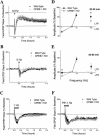Selective modulation of some forms of schaffer collateral-CA1 synaptic plasticity in mice with a disruption of the CPEB-1 gene
- PMID: 15169862
- PMCID: PMC419735
- DOI: 10.1101/lm.72704
Selective modulation of some forms of schaffer collateral-CA1 synaptic plasticity in mice with a disruption of the CPEB-1 gene
Abstract
CPEB-1 is a sequence-specific RNA binding protein that stimulates the polyadenylation-induced translation of mRNAs containing the cytoplasmic polyadenylation element (CPE). Although CPEB-1 was identified originally in Xenopus oocytes, it has also been found at postsynaptic sites of hippocampal neurons where, in response to N-methyl-D-aspartate receptor activation, it is thought to induce the polyadenylation and translation of alphaCaMKII and perhaps other CPE-containing mRNAs. Because some forms of synaptic modification appear to be influenced by local (synaptic) protein synthesis, we examined long-term potentiation (LTP) in CPEB-1 knockout mice. Although the basal synaptic transmission of Schaffer collateral-CA1 neurons was not affected in the knockout mice, we found that there was a modest deficit in LTP evoked by a single train of 100 Hz stimulation, but a greater deficit in LTP evoked by one train of theta-burst stimulation. In contrast, LTP evoked by either four trains of 100 Hz stimulation or five trains of theta-burst stimulation were not or were only modestly affected, respectively. The deficit in LTP evoked by single stimulation in knockout mice appeared several minutes after tetanic stimulation. Long-term depression (LTD) evoked by 1 Hz stimulation was moderately facilitated; however, a stronger and more enduring form of LTD induced by paired-pulse 1 Hz stimulation was unaffected. These data suggest that CPEB-1 contributes in the translational control of mRNAs that is critical only for some selected forms of LTP and LTD.
Figures








References
-
- Aakalu, G., Smith, W.B., Nguyen, N., Jiang, C., and Schuman, E.M. 2001. Dynamic visualization of local protein synthesis in hippocampal neurons. Neuron 30: 489-502. - PubMed
-
- Arai, A., Black, J., and Lynch, G. 1994. Origins of the variations in long-term potentiation between synapses in the basal versus apical dendrites of hippocampal neurons. Hippocampus 4: 1-9. - PubMed
-
- Barco, A., Alarcon, J.M., and Kandel, E.R. 2002. Expression of constitutively active CREB protein facilitates the late phase of long-term potentiation by enhancing synaptic capture. Cell 108: 689-703. - PubMed
Publication types
MeSH terms
Substances
Grants and funding
LinkOut - more resources
Full Text Sources
Molecular Biology Databases
Research Materials
Miscellaneous
